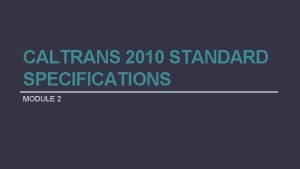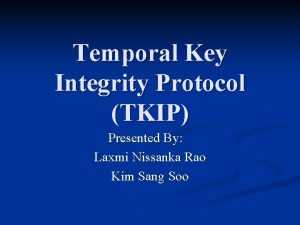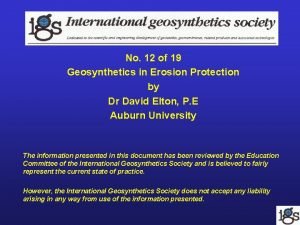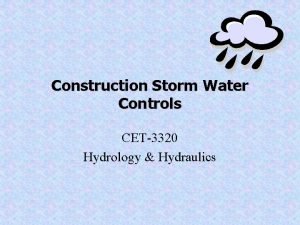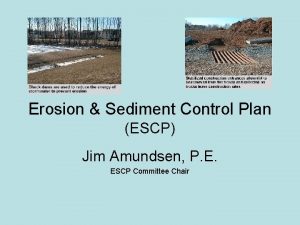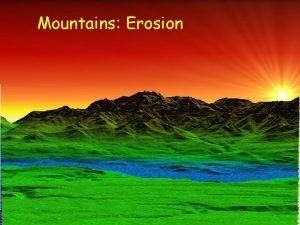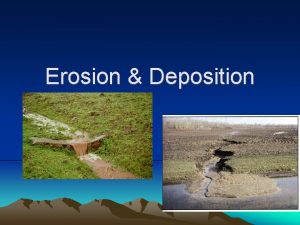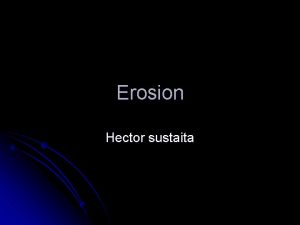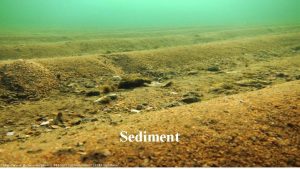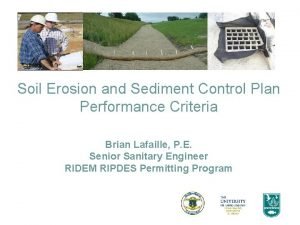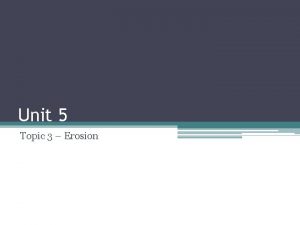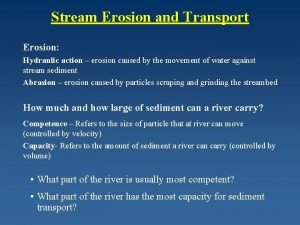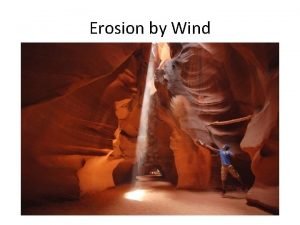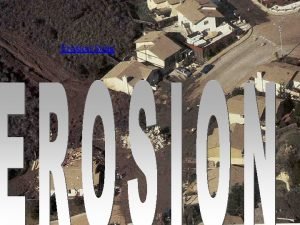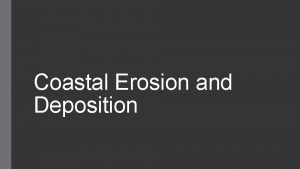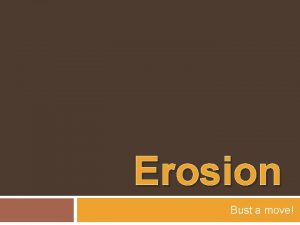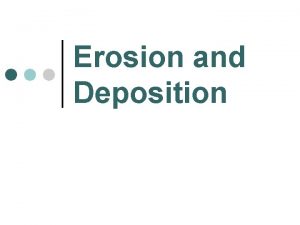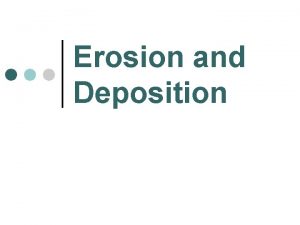Erosion Sediment Control Plan ESCP for Designers James





















- Slides: 21

Erosion Sediment Control Plan (ESCP) for Designers James E. Amundsen, P. E. Project Manager

ESCP – Why? Required by Statute • • • ISTEA Section 1057 TEA 21 reauthorized ISTEA Section 1057 Alaska Administrative code 18 Required by our own regulations • • • AASHTO Highway Drainage Preconstruction Manual (Hwy 1120. 7 & Avn 620. 1) Drainage Manual Ch. 16 Enforced by EPA NPDES Ø Individual liability for violations possible!

ESCP – Where? Ø Separate submittal with PS&E set (goes to DEC) Ø Include as Q sheets in Plans & an Appendix in the Specifications. And don’t forget to include: l l Ø Get new special Spec. Sect. 641 Hwy Get new special Spec. Sect. 157 Avn Plan sheets should show: l l l Pre-construction drainage & contours Drainage patterns, contours & BMP’s by Phase Final Plan drainage patterns, contours and permanent BMP’s

Erosion vs Sediment control Ø What is the difference?




Stariski Bridge in Water work



Other alternatives should be reviewed and considered for excavation in and adjacent to live water besides encapsulating the workzone. That was the biggest silt discharge impact at Stariski Bridge over the summer. Options considered included pumping to a container and then discharging through a filter sock, but it seemed overwhelming to try to pump groundwater while you are sitting in the creek placing riprap half-width, 3 -5 feet below the channel bottom. Our design also required the mixing of fines to fill the voids of the in channel riprap and to cap the new channel with 4 -inches of fines, which flushed down-stream as soon as we moved the diversion. Impact was short; 4 -days for all of the in –stream work, including placing the visqueen, supersack, and sandbag diversion and removing it.

Feedback from Construction Ø Ø Ø Ø Ø Estimate TEPC at 3 -5% of the Project cost for construction costs to comply with Permit requirements and the SWPPP. If a lump sum Item is used for TEPC, show the Design quantities for measures required/included in the LS Item. If a lump sum Item is used for TEPC, include a CS Item for added measures not included in the LS Item. Review the Permit requirements and clearly incorporate Permit commitments into the Contract. Create Items for as many measures as anticipated: Silt Fence; wattles; straw bales for mulching (invasive species free if hay bales are used. There is list created by the Homer Soil Conservation Service of suppliers on the Peninsula); Temporary Seeding; straw matting (SB-75 N with biodegradable thread, not plastic filament thread); and basins, slope drains, and check dams depending on the Project scope. Address the control or diversion of live water through the work zone in the Design phase. Establish a minimum 25 -foot protection zone along creeks and drainages that incorporates stage construction that minimizes clearing, retains a buffer zone, or reconstructs impacted areas. Give Construction as many tools as possible to be in compliance of the SWPPP and Permits. Acknowledge that an NOV for noncompliance is issued to the Construction Project Engineer; not the Designer, Project Manager, or Environmental Analyst. Our legacy precedes us.

BMP’s for the ESCP Construction Sequencing Ø Construction sequencing is a specified work schedule that coordinates the timing of land-disturbing activities and the installation of erosion and sediment control measures. The goal of a construction sequence schedule is to reduce on-site erosion and off-site sedimentation by performing landdisturbing activities and installing erosion and sediment control practices in accordance with a planned schedule (Smolen et al. , 1988). Ø Construction site phasing involves disturbing only part of a site at a time to prevent erosion from dormant parts. Grading activities and construction are completed and soils are effectively stabilized on one part of the site before grading and construction commence at another part. A key consideration of grading activities should be the coordination of cuts and fills to minimize the movement and storage of soils on, off, and around the site. This differs from the more traditional practice of construction site sequencing, in which sitedisturbing activities are performed initially for all or a large section of the site, leaving portions of the disturbed site vulnerable to erosion. To be effective, construction site phasing needs to be incorporated into the overall site plan early on.

Construction Site Operator BMP Inspection and Maintenance Stormwater control BMPs need regular inspections to ensure their effectiveness, and many permitting authorities require self-inspection for construction projects. Three types of BMP inspections are performed: routine inspections, inspections performed before rain events, and inspections performed after rain events. Ø Routine Inspections Routine inspections are an integral part of regularly performed maintenance activities--cleaning, repair, and replacement--necessary to ensure the integrity and effectiveness of BMPs. Construction site activities can damage BMPs. Earthmoving equipment, for example, can easily dislodge an entrenched silt fence. Routine inspection and maintenance minimizes the work required to prepare a site before a rain event, and it helps protect a site from unforeseen rains. Ø Inspections Before Rain Events It is critically important that construction site operators pay attention to weather forecasts. To prepare for impending rains, operators should walk the construction site and ensure that BMPs are cleaned out and operating properly. They should verify that dumpsters are covered, paint and other chemicals are covered, and no oil spills are present. Such housekeeping practices are routinely performed in all good inspection and maintenance programs. Operators should also visually inspect all BMPs when the site will be inactive for several days, such as weekends or holidays. This will help to prepare for rains that might occur when workers are off-site. Planning and preparation minimize the risk of on- or off-site property damage occurring because of inoperative or malfunctioning BMPs. Ø Inspections After Rain Events After a rain event, prepare the site for the next rain event. Typically within 48 hours after rain, inspect, clean, and repair the site's BMPs. This will keep the site "clean" and minimize complaints from nearby residents. To prevent health and safety hazards, remove mud in traffic areas and remove mosquito-breeding standing water. Clean mud and debris from silt fences and other BMPs. Clogged BMPs will not prevent pollutant releases during subsequent rain events, so clean, repair, or replace them as quickly as possible.

Preserving Natural Vegetation Ø Ø Ø Ø Ø The principal advantage of preserving natural vegetation is protecting desirable trees, vines, bushes, and grasses from damage during project development. Vegetation provides erosion control, stormwater detention, biofiltration, and aesthetic values to a site during and after construction activities. Other benefits of preserving natural areas are because natural vegetation Can process higher quantities of stormwater runoff than newly seeded areas Does not require time to establish Has a higher filtering capacity than newly planted vegetation because above ground and root structures are typically denser and using living root systems helps to hold soil in place Reduces stormwater runoff by intercepting rainfall, protecting soil surface from the impact of raindrops, holding soil particles in place, maintaining the soil's capacity to absorb water, promoting infiltration, and lowering the water table through transpiration Provides buffers and screens against noise and visual disturbance Provides a fully developed habitat for wildlife Usually requires less maintenance (e. g. , irrigation, fertilizer) than planting new vegetation Enhances aesthetics

Chemical Stabilization Ø Chemical stabilizers, also known as soil binders or soil palliatives, provide temporary soil stabilization. Vinyl, asphalt, or rubber are sprayed onto the surface of exposed soils to hold the soil in place and minimize erosion from runoff and wind. These materials are easily applied to the surface of the soil, can stabilize areas where vegetation cannot be established, and provide immediate protection.

Compost Blankets A compost blanket is a layer of loosely applied compost or composted material that is placed on the soil in disturbed areas to control erosion and retain sediment resulting from sheet-flow runoff. It can be used in place of traditional sediment and erosion control tools such as mulch, netting, or chemical stabilization. When properly applied, the erosion control compost forms a blanket that completely covers the ground surface. This blanket prevents stormwater erosion by (1) presenting a more permeable surface to the oncoming sheet flow, thus facilitating infiltration; (2) filling in small rills and voids to limit channelized flow; and (3) promoting establishment of vegetation on the surface. Composts used in compost blankets are made from a variety of feedstocks, including municipal yard trimmings, food residuals, separated municipal solid waste, biosolids, and manure. Ø Compost blankets can be placed on any soil surface: rocky, frozen, flat, or steep. The method of application and the depth of the compost applied will vary depending upon slope and site conditions. The compost blanket can be vegetated by incorporating seeds into the compost before it is placed on the disturbed area (recommended method) or the seed can be broadcast onto the surface after installation Ø

Mulching is an erosion control practice that uses materials such as grass, hay, wood chips, wood fibers, straw, or gravel to stabilize exposed or recently planted soil surfaces. Mulching is highly recommended and is most effective when used in conjunction with vegetation. In addition to stabilizing soils, mulching can reduce stormwater velocity and improve the infiltration of runoff. Mulching can also aid plant growth by holding seeds, fertilizers, and topsoil in place, preventing birds from eating seeds, retaining moisture, and insulating plant roots against extreme temperatures.

Permanent Slope Drains Ø Permanent slope diversions are designed to transport runoff down a slope in a manner that minimizes the potential for erosion. Diversions can be constructed by creating channels laterally across slopes to intercept the down-slope flow of runoff. The channels have a supporting earthen ridge on the bottom sides to reduce slope length, collect stormwater runoff, and deflect the runoff to outlets that convey it without causing erosion.

Where to find more BMP’s? Ø http: //cfpub. epa. gov/npdes/stormwater/me nuofbmps

Erosion Control AND Sediment Control Ø How much is enough? Ø What is the standard? l ALL “Reasonable and Practicable” measures Ø How much is enough? What ever it takes to avoid an NOV.
 Vittorio de pedys
Vittorio de pedys Escp
Escp Soil erosion diagram
Soil erosion diagram The logical view of a database:
The logical view of a database: Famous italian designer
Famous italian designer Inutamago
Inutamago Lobby schematic
Lobby schematic Gameplay
Gameplay Saints row 2 designer
Saints row 2 designer Caltrans standard plans
Caltrans standard plans Temporal key integrity protocol designers
Temporal key integrity protocol designers Harry beck work
Harry beck work Famous german fashion designers
Famous german fashion designers A systematic creative process for designers
A systematic creative process for designers Hard armor erosion control
Hard armor erosion control Economic importance of ocean
Economic importance of ocean Type of erosion
Type of erosion Biogenous sediments definition
Biogenous sediments definition Ocean currents map
Ocean currents map Sediment traps construction
Sediment traps construction Loose solid particles
Loose solid particles Christchurch bay sediment cell
Christchurch bay sediment cell









